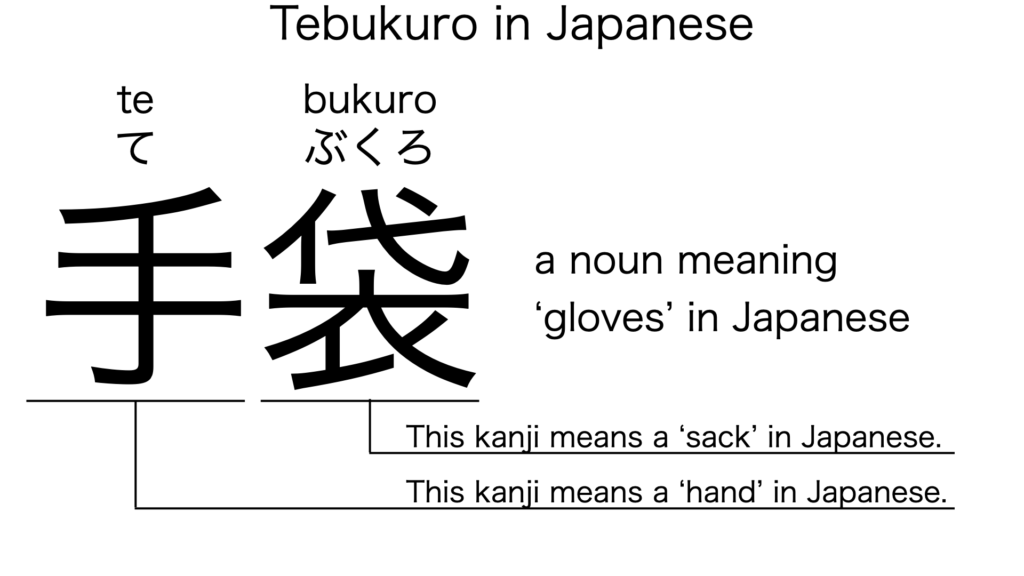What does “tebukuro” mean in Japanese?
Native speakers use tebukuro to mean ‘gloves’ in Japanese. Perhaps, some Japanese learners know this word as it is sometimes used in Japanese conversations. In this blog post, however, I’m explaining this word in detail based on its kanji expression. And also, I’m explaining how to use it through example sentences. My explanations would help Japanese learners understand tebukuro more clearly. Then, let’s get started!
Contents
Definition and meaning of “tebukuro”
Let me start with the definition and meaning of tebukuro.
- tebukuro – 手袋 (てぶくろ) : a noun used to mean ‘gloves’ in Japanese. This can also work as singular. Learn more about Japanese plural and singular.
Native speakers use this noun to refer to things they wear on their hands to keep their hands from getting cold or from something dangerous.
The definition and meaning are simple and clear. To understand this noun more clearly, however, let me explain its kanji characters in detail, one by one.
Tebukuro in kanji
The kanji expression of tebukuro consists of the following two kanji characters:
- 手 : a kanji character used to mean a ‘hand’ in Japanese.
- 袋 : a kanji character used to mean a ‘bag’, ‘sack’, or such in Japanese.
From these two kanji characters, we can understand that tebukuro literally means ‘hand sacks’ in Japanese. This literal interpretation is not completely in line with the actual meaning, but still very close, I think.

When we meet new kanji expressions, we should check their kanji characters in detail to understand their meanings clearly and deeply. In many cases, kanji characters tell us a lot about the meanings of the expressions they form. Actually, here, we could get the better understanding of tebukuro through the detailed kanji check above.
So far, I’ve explained the definition and meaning of tebukuro together with its kanji characters. Then, let me explain how to use it through the example sentences below.
How to say “gloves” in Japanese
boku wa atarashii tebukuro wo kai tai – 僕は新しい手袋を買いたい (ぼくはあたらしいてぶくろをかいたい)
I want to buy new gloves.
Below are the new words used in the example sentence.
- boku – 僕 (ぼく) : a pronoun meaning ‘I’ in Japanese. This is used mainly by boys and young males.
- wa – は : a binding particle working as a case marker or topic marker. In the example, this works after boku to make the subject in the sentence.
- atarashii – 新しい (あたらしい) : an i-adjective meaning ‘new’ in Japanese.
- wo – を : a case particle used to make the object word in a sentence. In the example, this is used after atarashii tebukuro to make the object in the sentence.
- kai – 買い (かい) : one conjugation of the verb, kau, which means ‘to buy’, ‘to get’, or ‘to purchase’ in Japanese. In the example, it has been conjugated for the better connection with its following word.
- tai – たい : an auxiliary verb used after a verb to make its desire form. Probably, this is well known as a part of the Japanese tai form. In the example, this is used after kai to make its desire form, kai tai, which means ‘to want to buy’ in Japanese.
This is a typical usage of tebukuro. In this example, it works together with the i-adjective, atarashii, to mean ‘new gloves’ in Japanese.
Another example of “tebukuro”
kono tebukuro wa totemo atatakai to omou – この手袋はとても温かいと思う (このてぶくろはとてもあたたかいとおもう)
I think this pair of gloves is very warm.
Below are the new words used in the example sentence.
- kono – この : a determiner used before a noun which refers to something close to the speaker. In the example, this is used before tebukuro to mean ‘this pair of gloves’ in Japanese.
- totemo – とても : an adverb of degree meaning ‘very’, ‘much’, ‘so’, or such in Japanese. In the example, this works in front of atatakai to mean ‘very warm’ in Japanese.
- atatakai – 温かい (あたたかい) : an i-adjective meaning ‘warm’ in Japanese.
- to – と : a case particle used as a quote marker. In the example, this is used after kono tebukuro wa totemo atatakai to indicate what the speaker thinks.
- omou – 思う (おもう) : a verb used to mean ‘to think’ in Japanese.
This is another example of tebukuro. In this example, it works together with the determiner, kono, to mean ‘this pair of gloves’ in Japanese.
Summary
In this blog post, I’ve explained the definition and meaning of tebukuro in detail based on its kanji expression. And also, I’ve explained how to use it through the example sentences. Let me summarize them as follows.
- tebukuro – 手袋 (てぶくろ) : a noun used to mean ‘gloves’ in Japanese. This can also work as singular. These two kanji characters literally mean ‘hand sacks’ in Japanese. This literal interpretation is not completely in line with the actual meaning, but still very close, I think.
Hope my explanations are understandable and helpful for Japanese learners.
Leave a Reply